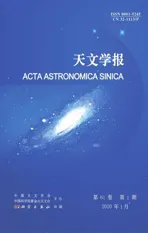宇宙再电离时期的kSZ效应和X射线背景与21 cm信号的互相关研究
2020-01-08马清波
马清波
(中国科学院紫金山天文台南京210033)
博士学位论文摘要选登
宇宙再电离是宇宙从黑暗时期到完全电离过渡的重要阶段, 也是宇宙学研究的一个非常重要的课题, 但是目前为止人们对宇宙再电离仍然缺乏足够精确的观测, 其中最大的问题是微弱的有效信号往往淹没于巨大的前景噪声中因而很难提取出来.本工作中研究了宇宙再电离时代的动力学苏尼阿耶夫-泽尔多维奇效应(Kinetic Sunyaev-Zel’dovich, kSZ)、X射线背景以及与中性氢的21 cm信息的互相关.由于不同观测途径之间的互相关能够有效去除不相干噪声的干扰, 这些研究成果有助于从未来的观测结果中提取出有用的宇宙再电离信号.
由于kSZ效应和21 cm信息(kSZ-21 cm)的互相关在小尺度上可以完全忽略,因此重点研究了kSZ平方(kSZ2)和21 cm信息(kSZ2-21 cm)的互相关.首先利用半解析数值模拟(21CMFAST)构建了宇宙再电离时代的kSZ效应的2维分布以及随红移演化的21 cm信息, 在此基础上计算了kSZ2-21 cm互相关及其随红移的演化.研究表明, 当宇宙的平均电离率xe0.7时, kSZ2的扰动主要由电离泡的分布主导,因此kSZ2-21 cm互相关为负; 而当0.8 xe<1时, kSZ2-21 cm互相关由中性氢的分布主导, 所以互相关为正.不同的是在非常高的红移处, 当xe< 0.15, 21 cm信息的扰动由与物质密度扰动正相关的自旋温度主导, kSZ2-21 cm互相关为正.kSZ2-21 cm互相关信号的观测需要首先用维纳滤波滤除原初宇宙微波背景辐射(CMB)在大尺度上的各向异性污染.研究发现, 平方公里阵列望远镜(SKA)和当前的地基CMB实验能够以很高的信噪比观测kSZ2-21 cm互相关, 如SKA∼10 h的积分和1.7′分辨率以及3.4µK噪声水平的CMB实验在xe=0.2、0.5、0.9时的信噪比分别能达到51、60、37.
宇宙再电离时代的X射线背景主要由X射线双星、中心吸积黑洞以及受激波加热的星际介质贡献.利用宇宙学流体动力学和辐射转移数值模拟研究了这些高能辐射源对宇宙X射线背景的贡献以及与21 cm信息的互相关.研究发现这些辐射源对宇宙X射线背景的贡献只占当前软频段0.5–2 keV的观测结果的∼5%以及硬频段2–8 keV的∼4%, 这些源对宇宙X射线背景分布的自相关功率谱的贡献小于当前观测结果的∼2%, 因此几乎无法直接用宇宙X射线背景的观测研究宇宙再电离.借助于21 cm信息的红移信息, 宇宙X射线背景和21 cm信息的互相关(Xray-21 cm)能够研究高红移X射线源的许多性质.研究表明, 在宇宙再电离的早期, Xray-21 cm互相关为正, 而当星系际介质被高度电离时, Xray-21 cm互相关则为负.Xray-21 cm互相关从正到负的过渡与高红移X射线源的模型以及研究的空间尺度的大小有关.一般来说, X射线源的辐射越强过渡发生的越早, 同时在越小的空间尺度上过渡也越早.以SKA望远镜作为21厘米实验的参考仪器, 并假设高精度X射线巡天实验能够分辨并移除辐射流量> 10−15erg·cm−2·s−1的X射线源, 2者的联合观测的信噪比< 1, 而如果X射线巡天实验能够识别>10−17erg·cm−2·s−1的X射线源, 那么在xe=0.5时累积的信噪比最高可以达到∼5.
Cross-correlation between kSZ Effect, X-ray Background, and 21 cm Signal from the Epoch of Reionization
MA Qing-bo
(Purple Mountain Observatory, Chinese Academy of Sciences, Nanjing 210033)
Epoch of cosmic reionization (EoR) is a very important era for the transition of our Universe dark ages to full ionized universe.It is also a very important issue in the study of cosmology.However, until now there are lack of precise measurements of EoR.One of the problems is that the huge foreground noise usually overwhelms the EoR signal, thus it is difficult to resolve the real signal from the observational data.In this thesis, I study the kinetic Sunyaev-Zel’dovich effect (kSZ), the X-ray background during EoR, and their correlations with the 21 cm signal of neutral hydrogen.Since the correlations between different measurements could efficiently remove their uncorrelated noises, our studies would help to measure the EoR signal from the observations in the near future.
Since the kSZ effect is proportional to the line-of-sight velocity, the kSZ-21 cm correlation suffers from cancellation at small angular scales.We thus focus on the correlation between the kSZ-squared field (kSZ2) and 21 cm signals (kSZ2-21 cm).We first build the 2-D distributions of kSZ effect and the 21 cm signals at different redshifts using the seminumerical simulations (21CMFAST), then study the kSZ2-21 cm correlations together with their evolution with redshift.It is found that, when the global ionization fraction is low(xe0.7), the kSZ2fluctuation is dominated by the rare ionized bubbles, that leads to an anti-correlation with the 21 cm signal.With 0.8 xe<1, the correlation is dominated by small pockets of neutral regions, leading to a positive correlation.However, at very high redshifts with xe<0.15,the spin temperature fluctuations change the sign of the correlation from negative to positive, since weakly ionized regions can have strong 21 cm signals in this case.To extract this correlation, Wiener filtering is effective in removing large signals from the primary CMB anisotropy.The expected signal-to-noise ratios for a ∼10-hour integration of upcoming Square Kilometer Array (SKA) data cross-correlated with maps from the current generation of CMB observatories with 3.4 µK noise and 1.7′beam over 100 deg2are 51, 60, and 37 for xe=0.2, 0.5, and 0.9, respectively.
The X-ray sources during EoR,that might contribute to the X-ray background, are the X-ray binaries, the accreting nuclear black holes, and the shock heated interstellar medium.We use high resolution hydrodynamical and radiative transfer simulations to study the contribution of these high-z energetic sources to the X-ray background and its correlations with the 21 cm signal.We find that these X-ray sources contribute only ∼5% of the unresolved X-ray background in the soft 0.5–2 keV band and ∼4% in the hard 2–8 keV band.The same sources contribute to less than ∼2% of the measured angular power spectrum of the X-ray background fluctuations.Thus it is impossible to study the EoR using only the X-ray background measurements.Using the redshift information of 21 cm signal, the correlation between X-ray background and 21 cm signal(Xray-21 cm) could be used to study the properties of the X-ray sources during the EoR.I find that Xray-21 cm correlations are positive during the early stages of reionization when most of hydrogen is neutral, while they become negative when the intergalactic medium gets highly ionized,with the transition from positive to negative depending on both the X-ray model and the scale under consideration.With SKA as the reference instrument for the 21 cm experiment, the predicted signal-to-noise ratio for such correlations is < 1 if the corresponding X-ray survey is only able to resolve and remove X-ray sources with observed flux >10−15erg·cm−2·s−1, while the cumulative signal-to-noise ratio at xe=0.5 is ∼ 5 if sources with observed flux >10−17erg ·cm−2·s−1are detected.
